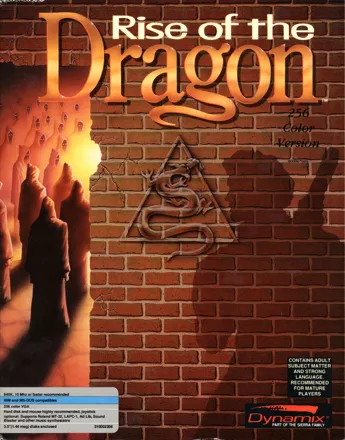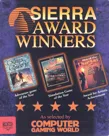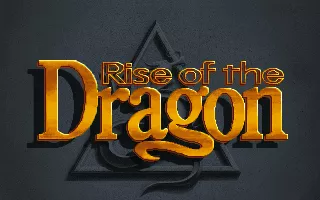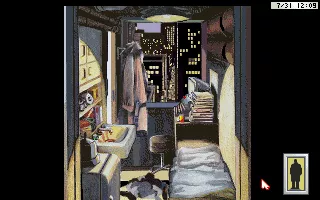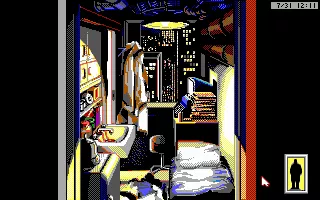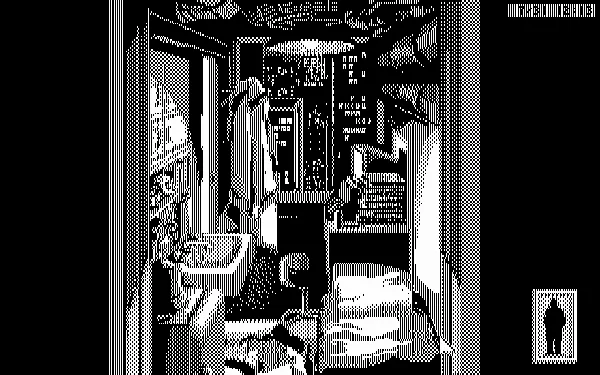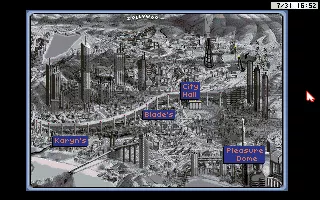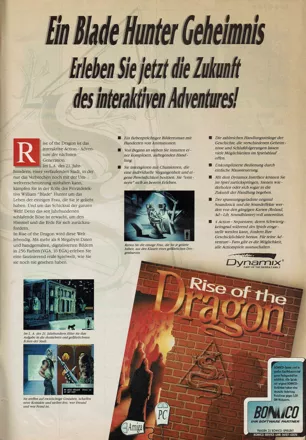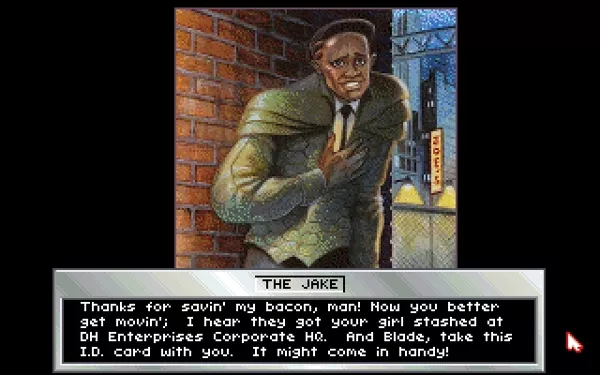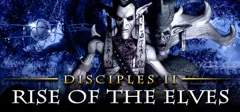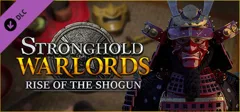Rise of the Dragon
Description official descriptions
The year is 2053, and Los Angeles has turned into a grim place ruled by crime and corruption. William 'Blade' Hunter is a private detective who once was a police officer. He is asked to investigate a horrible murder of the mayor's daughter, whose body was mutilated. As Hunter begins to search for clues that would help him solve the crime, he uncovers a conspiracy involving a deadly drug and a powerful criminal syndicate behind it.
Rise of the Dragon is a futuristic first-person adventure game. The game's visuals are reminiscent of a comic book, with digitized photos of actors and hand-painted backgrounds. Unlike most other adventure games of the time, it relies less on inventory puzzles and more on specific choices made by the player. The game has an internal clock and requires the player to plan the protagonist's moves ahead in order to be in the right place at the right time. Dialogues with multiple choices are utilized as a gameplay tool; a wrong choice will often lead to a premature end of the adventure.
There are two side-scrolling action sequences in the game; both can be bypassed without penalty if the player character dies several times in a row. The Sega CD version does not allow the player to skip these sequences. In addition, it uses a different color palette with a greenish tint, and has voice-overs for the dialogues.
Spellings
- ライズ オブ ザ ドラゴン ~ブレイド・ハンター・ミステリー~ - Japanese spelling
Groups +
Screenshots
Promos
Credits (DOS version)
19 People (17 developers, 2 thanks) · View all
| Designer and Director | |
| Art Director | |
| Conceptual Art and Characters | |
| Game Development System | |
| Artists | |
| Programmers | |
| Arcade Programming | |
| Audio Director | |
| Music and Sounds | |
| Original Score | |
| Dialogue and Text | |
| Original Story | |
| Quality Assurance Manager | |
| Documentation Design, Layout and Writing by | |
| Special Thanks to | |
| [ full credits ] | |
Reviews
Critics
Average score: 77% (based on 38 ratings)
Players
Average score: 3.8 out of 5 (based on 90 ratings with 12 reviews)
Hey, have you forgotten your key again?!..
The Good
Rise of the Dragon occupies a special place among adventure games of the early 1990's, being oddly similar to the Japanese specimens of the genre. Basically, the gameplay here is wrapped around the plot, and the focus is on natural, story-dictated advancement rather than on the essential Western adventure gameplay mechanic (puzzles). However, the game manages to squeeze quite a bit out of this less than promising template and, astonishingly, even introduce its own interesting ideas concerning adventure game design.
There is simple logic and realism in the game, which create an illusion of choice. Go out of your apartment without having collected your keys and you'll have a tough time getting back. Of course, you can always make your girlfriend angry by flirting with other women, and she'll flung the keys at you. However, you won't be able to solve the game without her help, so maybe you'll need to figure out another way to get back in. This kind of branching gameplay, as primitive as it is, feels uniquely refreshing after rigidly composed inventory puzzles or maddening "triggers" Japanese adventures are so fond of. Too bad it is barely used in this game.
The atmosphere in Rise of the Dragon is well-done. Beautiful backgrounds with occasional animation reflect the grim futuristic setting nicely. You can see people moving on the streets, neon signs flashing, apartment shaking when a helicopter flies by, etc. Events are presented with lovely comic book-like panels, emphasizing the game's dramatic pace. Despite the very simple interface, some objects that have nothing to do with the progression of the game can be examined, sometimes eliciting comments and thoughts from the main character. The game also has excellent sound effects and fitting music that further enhance the atmosphere.
The Bad
There is a bit too much of trial and error, particularly during the final part of the game or in some of the puzzles. The platform sequence near the end of the game has clunky, stiff controls, and is too hard. It was nice of the game to allow me to skip it and go straight to the final cutscene, but the feeling of achievement and reward was gone. An easier arcade sequence or at least the possibility to save within it would have been more appropriate.
The story is just one big cliche. I couldn't see the necessity of blatantly ripping off the movie Blade Runner in such insignificant details as the hero's name - and honestly, "Blade Hunter" is one of the worst protagonist names I've come across. It all boils down to the confrontation against a cartoony villain; there are no twists or psychological insights of any kind, and all the characters are completely one-dimensional and forgettable.
A much more serious problem is the game's size. More often than not I felt that the developers were showing me brilliant sketches rather than a complete, full-fledged product. For example, the hero's apartment is a fantastic location, but there is no other one like that to explore. Only a few spots allow interactivity, while most others are disappointingly empty. Branching plot could have been done much better as well. I understand that hooking up with a prostitute won't make your girlfriend happy, but why make the game unwinnable because of that?
Rise of the Dragon starts strong, but cannot stay on the same level throughout. By the end of the first game day you'll have seen and experienced pretty much everything the game has to offer. Afterwards, it mostly consists of a fairly monotonous routine: repeated trips to the same barren locations, a few minor discoveries here and there, and a flat, predictable cartoony showdown without any significant events along the line.
The Bottom Line
Rise of the Dragon might be what Japanese adventures always wanted to be: a smooth, cinematic experience that transcends its apparent weaknesses. Unfortunately, that doesn't mean much. Despite the obvious talent behind it, the game comes across as a rather shallow and rudimentary product compared to its more developed Western siblings.
DOS · by Unicorn Lynx (181780) · 2015
Not as good as it claims to be
The Good
I admit I am not very much impressed by this game, but I am addicted to it, more than my REALLY favourite games. From time to time I want to explore its micro-pseudo-virtual real-time world, watch the time as it passes, and the beautiful sceneries.
What I like is mainly its atmosphere. First of all I like Blade Hunter. He, as well as the story itself, are cliches, but it seems like he jumped out from a classical story... a futuristic detective archetype, as I would imagine him: trench coat, ponytail, scar on a cheek, and the replies he gives (most of them chosen by you) are really in accordance to his personality. Blade Hunter IS a well-developed character, no matter how small is the game, no matter that won't see him again in a future game.
Although I don't really enjoy, I appreciate that Dynamix attempted to create a self-efficient game world, as realistic as possible, with distances, time that passes, day night circles, characters with their own personalities and different ways to talk to them, alternative solutions and alternative endings. Although the designers didn't take fully advantage of its full potential, sometimes you have the feeling that you are actually visiting that micro-world: everyone has a vidphone device (note that there is a [useless] 'cellular vidphone in the hovercar. A red herring, but also a touch of realism.), everyone needs chocolate, everyone is lost in the dystopian future, and lost according to his own character.
The manual is something that everyone would like: an imaginary magazine featuring a comic with Blade, and except that, advertisements, articles, mail, that put you in Blade's world, with a lot, a lot of humor.
As I said, despite small, the game is quite deep. After 10 years, I just learned that the game doesn't end when you lock yourself out, forgetting your ID in your house. Actually you don't really need it! There is a way to enter your apartment without it and I just learned the way!!! I am sure there are some other 'secrets' that I haven't seen in any walkthrough... yet
There are also some touches of reality, like the name of the person you talk to, that appears in the dialogue box (if you know it), or not (if he hasn't introduced). However this isn't actually useful in the gameplay or the plot development.
I also like how arcade can interact with the rest of the game. Having used too many mini-bombs will prevent you from using them in the arcades. If you manage to claim some useful stuff, like the vest, will make the arcades easier. And no, I don't think that they are THAT frustrating as some think
The Bad
As I said, the game doesn't really takes advantage of a REAL virtual reality it claims to represent. Apart from some alternative solutions to puzzles, and various ways to approach persons or situations, there are no real plot branches.
For example offering Karyn flowers will trigger the date/dinner cutscene. But the plot won't evolve differently from the gamer who missed the opportunity.
The characters of the bar are an example. You can just play with them, try some alternate responses to see how they react. But all this is possible, during day one. After that, you can't 'explore' or play any more and it won't affect the plot (apart that you can be led to a dead-end with a wrong reply).
Also, in dialogues the game tries to be so realistic, that it manages to be unrealistic. Each dialogue is unique, a taken or lost opportunity. You can't retry a dialogue, even if in reality you wanted to ask a question you missed before. In the game, the question will be lost for ever
The manual tries to convince you how important a feat to make a 'virtual reality' game it was.
Some things will be used once, and they need their appropriate time and place. While some can be used to pass alternatively through some dead end (if you missed an opportunity earlier), others, like the Napent, won't help you pass through other difficult situations. The Napent can be used only once, or other times FOR FUN without changing the story. Not as versatile as I'd like.
Time passes realistically, indeed, but only to distress you. Almost nothing changes through day and night. Persons will be there always, except the City Hall. Quest for Glory was more realistic! There is no puzzle which you can/must do BECAUSE it's night and everyone would be absent.
Also, some scenery is ugly. The hand-drawn graphics are indeed comic-like, but sometimes they are poor. Blurry, unclear, the rough outlines are not what you'd expect to see in a comic book.
Finally, the arcades, although enjoyable, they are ridiculous. A VGA arcade game with early 80's gameplay: totally unrealistic walk, jump and movements, and slow, slow bullets. The bad guys can be shot once, while you need several shots to die.
The Bottom Line
I think it's worth looking, a classical game with many many good elements. Too bad it was not fully implemented, at least as much as the documentation wanted us to convince it is.
DOS · by Boston Low (85) · 2006
The Good
The year is 2053 and the setting is dirty Los Angeles. Former private investigator, William “Blade” Hunter, is asked by Mayor Vincenzi to find out who or what killed his daughter, Chandra. It happens to be an election year, so Vincenzi doesn't want the investigation to be leaked to the press. He gives Blade several leads to get started: Chandra was last seen in the Pleasure Dome, hanging out with some guy known as “The Jake”. Blade should talk to The Jake and show him a “vid-transmission hardcopy” of Chandra.
There are at least three versions of Rise of the Dragon, and each of them has their own advantages and disadvantages. The Sega CD version has full speech, which is what the other two versions lack. The different characters are voiced by professional actors, including Cam Clarke, who plays the part of Blade. Like in other versions, you are likely to choose some responses when you are talking to someone. Whether you choose the right responses will determine if they are kind afterwards, or are angry at you. I enjoyed getting an angry reaction from them. Having completed the Sega CD version, I have to say that the speech very much adds to the game's atmosphere. The voices that I like include those belonging to all the Chinese characters, especially Jonny Qwong and Deng Hwang.
Another advantage over the DOS/Amiga versions is the use of great sound effects. These can be heard in scenes when lightning strikes, when someone fires a gun, or when a bomb is exploded. And you can hear machines doing their shit when you spy into the enemy's warehouse. I mostly heard them from playing the arcade sequences, dealing with the different hazards that block your way.
The Bad
There is one scene where Karyn and Blade go out for dinner, but that scene is censored. This is despite the game given a MA-17 rating by the VRC. Anyone who has played the DOS or Amiga version will surely know that both characters don't just go out for dinner, they sleep together as well.
Due to the Sega CD's limited color palette, the graphics have a green tint to them. Although that is bad, I like to think that the game deserves it due to its “MTZ” drug theme. Before Dynamix went ahead of the game, they should have waited one more year when the Saturn came out. By then, they would have incorporated graphics that have more colors than the other versions, making it look more like a futuristic thriller. As well this, they would have made further enhancements to the game.
The Bottom Line
Despite the censorship and the green graphics, the Sega CD version of Rise of the Dragon has one notable advantage over other versions before it: full speech. This adds to the atmosphere of the game. Other advantages include great sound effects, that can be best enjoyed during the arcade sequences. So if you have already played either of the other versions, I would recommend getting hold of the Sega CD version and see how good it is.
SEGA CD · by Katakis | カタキス (43091) · 2007
Trivia
Development
Rise of the Dragon appears to have been coded in Turbo C++.
Messages
Messages hidden in the main executable:
Boy, am I tired. Better get some sleep in about an hour.You have chosen to run the game with only %s bytes of memory! You are on your own!(this is presumably when the user has decided to run the game without enough free DOS memory available)
References
- One of the patrons in the Pleasure dome is named "FU BAR".
- David Wolf makes an appearance outside the Pleasure Dome--he strolls past in a tuxedo if you wait long enough. (David Wolf was the main hero of Dynamix's earlier game David Wolf: Secret Agent.)
- In Heart of China, another game from Dynamix, if you talk to some people in Ho's bar, some people will say "Bahumat lives!". A reference to the main villain in Rise of the Dragon.
SEGA CD version
The Sega CD has automatically-converted graphics from the 256-color originals, but (probably due to the Sega's limited color palette and palette restrictions) everything has a green cast. Check screenshots for comparison. Also some things were cut from the game: an ammo clip besides a telephone, all but one strippers in the bar and a sequence in which the protagonist has sex.
Versions
Rise of the Dragon was released in two separate packages for the PC: A 256-color VGA/MCGA version that took up about 7 megabytes, and an EGA/CGA version that, understandably, took up half that size. The 16-color EGA version, on the other hand, has mostly redrawn graphics based on the 256-color originals.
Awards
- Computer Gaming World
- November 1991 (Issue #88) – Special Award for Artistic Achievement
- November 1996 (15th Anniversary Issue) - #83 in the “150 Best Games of All Time” list
- November 1996 (15th anniversary issue) – #12 Most Innovative Computer Game
Information also contributed by PCGamer77
Analytics
Upgrade to MobyPro to view research rankings!
Related Sites +
-
Game Nostalgia
Provides extensive background info for Rise of the Dragon, pictures of the cast, full credits with shots and info about the design team, specific details about the game, various goodies, all musical themes, shots of every location in the game, saved games, a list of reviews, including a "nostalgic "review and tech specs.
Identifiers +
Contribute
Are you familiar with this game? Help document and preserve this entry in video game history! If your contribution is approved, you will earn points and be credited as a contributor.
Contributors to this Entry
Game added by Trixter.
SEGA CD, Amiga added by POMAH. Windows added by Cavalary. Macintosh added by Terok Nor.
Additional contributors: Shoddyan, Sciere, martin jurgens, Patrick Bregger, Starbuck the Third, ZeTomes, Shankao, Kayburt.
Game added March 20, 1999. Last modified January 27, 2024.
